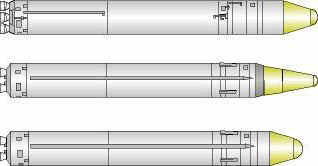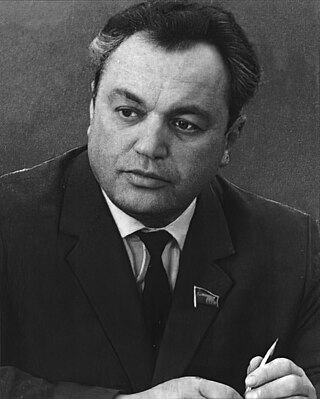This article's factual accuracy may be compromised due to out-of-date information.(April 2017) |
Below is a list of missiles , sorted alphabetically into large categories and subcategories by name and purpose.
This article's factual accuracy may be compromised due to out-of-date information.(April 2017) |
Below is a list of missiles , sorted alphabetically into large categories and subcategories by name and purpose.
Types of missiles:

An intercontinental ballistic missile (ICBM) is a ballistic missile with a range greater than 5,500 kilometres (3,400 mi), primarily designed for nuclear weapons delivery. Conventional, chemical, and biological weapons can also be delivered with varying effectiveness, but have never been deployed on ICBMs. Most modern designs support multiple independently targetable reentry vehicle (MIRVs), allowing a single missile to carry several warheads, each of which can strike a different target. The United States, Russia, China, France, India, the United Kingdom, Israel, and North Korea are the only countries known to have operational ICBMs.
NATO uses a system of code names, called reporting names, to denote military aircraft and other equipment used by post-Soviet states, former Warsaw Pact countries, China, and other countries. The system assists military communications by providing short, one or two-syllable names, as alternatives to the precise proper names – which may be easily confused under operational conditions or are unknown in the western world.

A ballistic missile (BM) is a type of missile that uses projectile motion to deliver warheads on a target. These weapons are powered only during relatively brief periods—most of the flight is unpowered. Short-range ballistic missiles (SRBM) typically stay within the Earth's atmosphere, while most larger missiles are exo-atmospheric. The largest ICBMs are capable of full orbital flight. These weapons are in a distinct category from cruise missiles, which are aerodynamically guided in powered flight and thus restricted to the atmosphere.

A submarine-launched ballistic missile (SLBM) is a ballistic missile capable of being launched from submarines. Modern variants usually deliver multiple independently targetable reentry vehicles (MIRVs), each of which carries a nuclear warhead and allows a single launched missile to strike several targets. Submarine-launched ballistic missiles operate in a different way from submarine-launched cruise missiles.
A ballistic missile submarine is a submarine capable of deploying submarine-launched ballistic missiles (SLBMs) with nuclear warheads. These submarines became a major weapon system in the Cold War because of their nuclear deterrence capability. They can fire missiles thousands of kilometers from their targets, and acoustic quieting makes them difficult to detect, thus making them a survivable deterrent in the event of a first strike and a key element of the mutual assured destruction policy of nuclear deterrence. The deployment of ballistic missile submarines is dominated by the United States and Russia. Smaller numbers are in service with France, the United Kingdom, China and India; North Korea is also suspected to have an experimental submarine that is diesel-electric powered.

Project 629, also known by the NATO reporting name Golf, was a class of diesel-electric ballistic missile submarines that served in the Soviet Navy. All boats of this class had left Soviet service by 1990, and have since been disposed of. According to some sources, at least one Golf-class submarine was operated by China, to test new submarine-launched ballistic missiles (SLBMs).

Active radar homing (ARH) is a missile guidance method in which a missile contains a radar transceiver and the electronics necessary for it to find and track its target autonomously. The NATO brevity code for an air-to-air active radar homing missile launch is fox three.

An air-to-surface missile (ASM) or air-to-ground missile (AGM) is a missile designed to be launched from military aircraft at targets on land or sea. There are also unpowered guided glide bombs not considered missiles. The two most common propulsion systems for air-to-surface missiles are rocket motors, usually with shorter range, and slower, longer-range jet engines. Some Soviet-designed air-to-surface missiles are powered by ramjets, giving them both long range and high speed.

The UR-100N, also known as RS-18A, is an intercontinental ballistic missile in service with Soviet and Russian Strategic Missile Troops. The missile was given the NATO reporting name SS-19 Stiletto and carries the industry designation 15A30.
The RT-21 Temp 2S was a mobile intercontinental ballistic missile developed by the Soviet Union during the Cold War. It was assigned the NATO reporting name SS-16 Sinner and carried the industry designation 15Zh42 (15Ж42).

The RT-15 was a mobile theatre ballistic missile deployed by the Soviet Union during the Cold War. It was assigned the NATO reporting name SS-14 Scamp and carried the GRAU index 8K96.

Viktor Petrovich Makeyev was a Soviet engineer in the Soviet space program who was also a central and founding figure in development of Submarine-launched ballistic missile (SLBM) for the Soviet Navy.
JSC Votkinsk Machine Building Plant is a machine and ballistic missile production enterprise based in Votkinsk, Republic of Udmurtia, Russia. Its production includes the RS-24 Yars intercontinental ballistic missile, Russia's most recent ICBM development, as well as the submarine-launched Bulava SLBM.

A nuclear triad is a three-pronged military force structure of land-based intercontinental ballistic missiles (ICBMs), submarine-launched ballistic missiles (SLBMs), and strategic bombers with nuclear bombs and missiles. Countries build nuclear triads to eliminate an enemy's ability to destroy a nation's nuclear forces in a first-strike attack, which preserves their own ability to launch a second strike and therefore increases their nuclear deterrence.